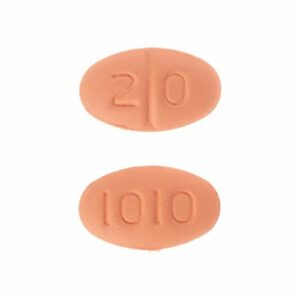OCD, or obsessive-compulsive disorder, is a mental health condition that can be debilitating for those who suffer from it. It can cause intrusive thoughts and repetitive behaviors that make it difficult to live a normal life. There are many different treatments available for OCD, one of which is citalopram. In this comprehensive guide, we will discuss everything you need to know about citalopram and how it can help treat OCD.
Contents
What Is Citalopram?

Citalopram is a medication sold by the brand name Celexa. It’s an antidepressant that belongs to a class of drugs called selective serotonin reuptake inhibitors (SSRIs). SSRIs work by increasing the level of serotonin in the brain, which can help improve mood and relieve symptoms of OCD. Citalopram is approved by the FDA to treat major depressive disorder and anxiety disorders such as panic disorder and OCD.
It’s important to note that citalopram is only meant to be used as a short-term treatment for OCD. It’s not recommended for long-term use due to the potential for side effects and risks associated with taking the medication.
Studies On Citalopram
A study published in the Journal of Clinical Psychiatry found that citalopram was more effective than a placebo in treating OCD. The study looked at adults with OCD who were treated with citalopram for 12 weeks. The participants were then monitored for an additional 12 weeks after they stopped taking the medication. The results showed that those who took citalopram had a significantly lower rate of relapse than those who took a placebo.
A study published in The American Journal of Psychiatry compared the efficacy of citalopram and fluoxetine in treating OCD. The study found that both medications were equally effective in reducing OCD symptoms. However, citalopram was associated with a lower rate of side effects than fluoxetine.
In one study, citalopram was found to be more effective than a placebo in treating OCD after 12 weeks of treatment. Citalopram was also found to be more effective than the antidepressant clomipramine in treating OCD.
Another study suggested that citalopram may be as effective as exposure and response prevention (ERP), a common type of behavioral therapy for OCD.
Citalopram has been proven to be effective in reducing symptoms of OCD in multiple clinical trials. Hence, FDA (Food and Drug Administration) has approved it for the treatment of OCD in adults.
How Does It Work?
The principle behind the working of citalopram is pretty simple. As it is a serotonin reuptake inhibitor, so it prevents the reabsorption of serotonin in the brain. This leads to an increase in the level of serotonin in the synaptic space. Now, as we know that serotonin is pretty important when it comes to modulating mood and emotions, so an increase in its level results in a better mood and an easing of anxiety. This is how citalopram works.
Who Can Take It?

Citalopram is generally well-tolerated, but there are some people who should not take it. If you have a history of heart disease, seizures, or bipolar disorder, you should not take citalopram. You also should not take citalopram if you are pregnant or breastfeeding. If you are taking any other medications, please be sure to speak with your doctor before starting citalopram.
Most adults can take citalopram, though it should be noted that the medication has not been studied in children.
Citalopram may not be the right treatment for everyone with OCD, but it has been shown to be effective in treating the condition.
How Is It Clinically Used?
Doctors usually start patients with OCD on a low dose of citalopram and increase the dose slowly over time. The usual starting dose is 20 mg per day, but some people may need a higher or lower dose. The maximum recommended dose is 60 mg per day.
Citalopram can be taken with or without food, but it is important to take it at the same time each day. It should be taken in the morning if you are taking it once a day, or it can be taken in two divided doses if you are taking it twice a day.
Citalopram may take several weeks to work. You should not stop taking citalopram suddenly as this can cause withdrawal symptoms. If you need to stop taking citalopram, your doctor will slowly reduce your dose over time.
Side-effects
Citalopram is generally well-tolerated, but it can cause some side effects.
Short Term Effects

The most common side effects include:
- Nausea
- Headache
- Dry mouth
- Dizziness
- Fatigue
- Frequent urination
- Joint pain
- Decreased libido
- Erectile dysfunction
- Muscle twitches or rigidity
- Insomnia
These side effects are usually mild and go away on their own after a few weeks.
Long-Term Effects
There are also potential risks associated with taking citalopram. Some of the most common risks include:
- Serotonin syndrome: This is a rare but potentially life-threatening condition that can occur when taking SSRIs. Symptoms include high body temperature, changes in blood pressure, muscle rigidity, and seizures. If you experience these symptoms, you should seek medical help immediately.
- Anxiety: Citalopram can cause anxiety or make it worse. If you have a history of anxiety, you should discuss this with your doctor before starting citalopram.
- Agitation: Citalopram can cause agitation, which can be a problem for some people.
- Mania: It can cause mania in some people. This is more common in people with bipolar disorder, but it can occur in people without bipolar disorder as well. If you experience any symptoms of mania, you should seek medical help immediately.
- Seizures: Citalopram can cause seizures in some people. If you have a history of seizures, you should discuss this with your doctor before starting citalopram.
- QT prolongation: This is a rare but potentially life-threatening condition that can occur when taking citalopram. Symptoms include irregular heartbeat and fainting.
- Type-2 diabetes: Some studies have found that citalopram can increase the risk of type-II diabetes.
- Weight gain: Citalopram can cause weight gain in some people.
These side effects are rare but can be potentially life-threatening. If you experience any of these side effects, you should seek medical help immediately.
Precautions

If you are considering taking citalopram for OCD, there are some things you should keep in mind.
- Citalopram is not a cure for OCD and it will not eliminate all of your symptoms. However, it can help to reduce the intensity and frequency of your symptoms and make them more manageable.
- Citalopram can take several weeks to start working, so it is important to be patient and give the medication a chance to work.
- Citalopram may cause withdrawal symptoms if it is stopped suddenly, so it is important to taper off the medication gradually under the supervision of a doctor.
- Citalopram can interact with other medications, so it is important to speak with your doctor about all of the medications you are taking before starting citalopram.
- You should avoid alcohol while taking citalopram, as it can increase the risk of side effects.
- It is also advised to avoid operating heavy machinery until you know how citalopram will affect you.
- Citalopram may also increase the risk of suicidal thoughts or behaviors. If you have any thoughts of harming yourself while taking citalopram, please call your doctor or go to the emergency room immediately.
Avoiding these things can help to reduce the risk of complications and make citalopram treatment more effective. Citalopram is a medication that can be effective in treating OCD. If you are considering taking citalopram for OCD, please speak with your doctor to see if it is right for you.
Alternatives

There are alternative medicines available for treating OCD. Some alternative medications include:
- Fluoxetine: Fluoxetine is an anti-depressant that is also used to treat OCD. It works by increasing levels of serotonin in the brain.
- Fluvoxamine: Fluvoxamine is an anti-depressant that is also used to treat OCD. It works by blocking the reuptake of serotonin in the brain.
- Clomipramine: Clomipramine is a tricyclic anti-depressant that is also used to treat OCD. It works by inhibiting the reuptake of serotonin and norepinephrine in the brain.
- Sertraline: Sertraline is an anti-depressant that is also used to treat OCD. It works by inhibiting the reuptake of serotonin in the brain.
- Paroxetine: Paroxetine is an SSRI that is also used to treat OCD. It works by increasing levels of serotonin in the brain.
These medications work in a similar way to citalopram and can be effective in treating OCD.
Some alternative treatments do not require medication. Some of these include:
- Cognitive Behavioral Therapy (CBT): Cognitive behavioral therapy is a type of therapy that can help to change the thoughts and behaviors that contribute to OCD.
- Exposure And Response Prevention (ERP): Exposure and response prevention is a type of therapy that involves gradually exposing yourself to the things that trigger your OCD and learning to control your response to them.
- Family Therapy: Family therapy can help to improve communication and family relationships.
- Psychodynamic Therapy: Psychodynamic therapy can help to identify and address the underlying causes of OCD.
These are just a few of the alternative treatments that are available for OCD. If you prefer treatment without medication, you might consider going for this.
Conclusion
Lastly, citalopram has been long approved by FDA and is also considered one of the most essential medications for the treatment of depressive and anxiety disorder by the WHO (World Health Organization). It is a commonly prescribed anti-depressant for treating OCD as well. If you are considering taking citalopram for OCD, please speak with your doctor to see if it is right for you.
If you are struggling with OCD, know that you are not alone. There are many resources available to help you cope with this condition. Reach out to Therapy Mantra for help getting started on the road to recovery. We have a team of mental health professionals who specialize in treating OCD. Our specialists can help you develop a treatment plan that meets your specific needs. Contact us today to book an online therapy or download our free OCD treatment app on Android or iOS for more information.


